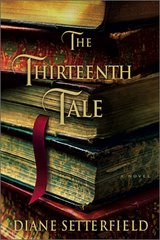At the meeting, we talked a bit about in what time period "The Thirteenth Tale" may have been set. I looked around a bit and found a few interesting theories:
From a blog about all things Bronte:
It is never specified when the novel is set in a deliberate attempt to suspend the real world outside the novel. Nevertheless there are clues around the novel that more or less point to dates about the late seventies or the eighties .
Note: This blog does not go into the details of the clues.
From an Epinions review:
The novel includes several stories, each intertwined throughout the book. The time period is unknown, although we get the impression that it’s in the mid 1900’s, which I conclude because you have cars, yet lack some more modern conveniences.
And, my favorite opinions, from a Barnes and Noble message board:
I also had a hard time figuring out the time frame. There were hints given along the way but I never noticed any confirmed dates. When the story was being told about Adeline and Emmeline, dressing gowns, coach houses and perambulators were some words used.
It does mention on page 380;
"Emerging from the trees, I approached the scene. A fire engine. Villagers with buckets,...watching the professionals do battle with the flames....An ambulance."
On page 382;
"The hospital. opening the ambulance doors...The stretcher, lifted onto a trolley and wheeled away at speed. The wheelchair."
These references didn't make it seem as old as I thought earlier.
--------------------------------------------------
As I was finishing the book, I realized there were no intrusions on the story from the "outside world" - no world events, no wars or revolutions, no discoveries mentioned. The passage of time is really only noted when "shifts" between stories occur. None of the characters really "age" gradually since each story Miss Winter tells Margaret is more of a snapshot separated by a number of years. The "twins" are babies, then school-age, then pre-teen, then teen, and last, in two cases, elderly. The realization made the isolation of the characters that much more profound. The only character given a relative age is Aurelius, who if I remember correctly is noted as being around 60. From there I extrapolated ages for the other characters: Miss Winter (75 to 80 since she was at least past age 13 and under 20 when Aurelius was born), Aurelius's sister Karen (40s - since their father was absent from Angelfield for around 15 years or so), and Margaret (late 30s or early 40s).
The sequences involving Charlie and Isabelle are pre-automobile (so 1890s to early 1900) but when Hester arrives there are automobiles mentioned (if I remember correctly) placing that part of the story near World War I (and Isabelle's death from influenza would occur before 1920). Margaret would enter the story in the 1960s (giving Aurelius time to grow up and Ambrose to join the military and return to Angelfield), allowing for the absence of computers (all the communication is done via letter) and lack of transportation in the more rural areas of England.
Just my thoughts.
-------------------------------------------------
I think the book is set at the turn of the 20C because of the descriptions of the dresses, furnishings etc. It has a 'Brideshead re-visited' feel to it (1915), especially the party where Isabelle met Roland. There is also a hint of the sumptuousness of furnishings in The Picture of Dorian Gray (1890). As the family were wealthy, a car could have been a family possesion at that time - Rolls Royce's were available in 1906.
--------------------------------------------------
Interesting point about the wealth of the family and the Rolls Royce being available in 1906. So, if Vida was 15 when she traveled by car to see the family's solicitor, add about 60 years to her age, because she is elderly when she tells her story to Margaret, and that would put the timeframe around 1966.
--------------------------------------------------
I am so fascinated to read the many and varied theories about the date of the stories, and also intrigued to see how much and how little the dating of a story matters to different readers.
I gave the timeframe question a lot of thought when I was writing the book, and it's one of the aspects that drew the most questions when I was touring bookshops recently in the US. For myself as a reader it does not distress me in the least not to know when a story is supposed to take place. Although I read plenty of books set in solidly recognisable historical contexts, I am equally happy and sometimes more so to read a novel that transcends reality and is set in some imaginary world (the magic realist tradition for instance). I often wonder whether any child in the history of reading has asked 'When was Cinderella set?' and it seems to me that as The Thirteenth Tale is a fairy tale for grown-ups, it is appropriate that it should be set in a place where time is not measured quite as it is for us.
Do any of you have any new ideas?
Subscribe to:
Post Comments (Atom)


1 comment:
We do know Isabelle wore canvas lace up shoes, not available as scuffed trainers or sneakers. These were much more common in the 1930’s-1940’s. It also depends whether or not the author was an avid fashion historian or not. In England one does not have bangs, i, instead have a fringe. That was a strong tell , and there were a few others that smacked of “ American”
Post a Comment